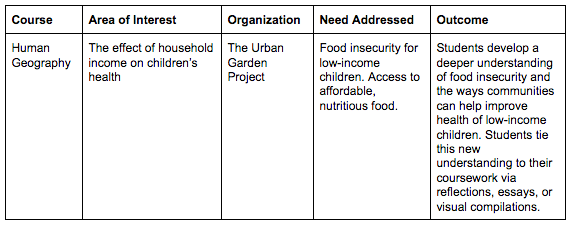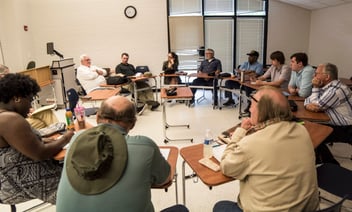A Guide for Instructors and Academic Chairs
Service learning enables students to address needs in their community as part of an academic course. Service learning integrates the practice of volunteerism with educational objectives.
There are countless benefits for students who participate in service learning opportunities. Students learn to exercise leadership and develop transferable skills like collaboration and problem-solving. They are given the chance to work through real challenges and contribute to meaningful change, instilling a sense of citizenship that extends into adulthood. Students benefit especially when working with individuals different from themselves, so it’s important to encourage students to look for opportunities that are outside of their usual circles.
More campuses are incorporating service learning into their curricula each year. Schools have the resources to effect real change within their communities while fostering civically engaged students. Through service learning, your campus becomes a force for good.
For more on the “what” and “how” of service learning, check out this article.
Keep reading to learn service learning best practices for both instructors and academic chairs (or department heads) who want to bring service learning into their classrooms.
Service Learning Best Practices for Instructors
Here's what service learning instructors need to know:
Understand Your Role as Instructor
Adding service learning to your course can be a rewarding experience for teachers, but you may also find that you have to adjust your teaching style. Traditional classroom environments tend to be teacher-centered.
Incorporating service learning into your classroom offers the opportunity to foster a more collaborative learning environment.
You may find that taking on a mentor role will help you better prepare students to serve the community. Here are the best service learning practices for preparing students:
- Develop an understanding of the needs they, alongside partner organizations, will help to address.
- Make sure students understand that members of the community may have different values, income, and experiences. Every individual should be treated with dignity and respect.
- Ensure students are aware that they are representatives of the school, and should present themselves accordingly.
- Let students know that if they ever feel uncomfortable or unsafe, they should come to you immediately.
If your campus has a service learning department, program leads will generally be responsible for reaching out to organizations in your community to form a partnership. Furthermore, the community organizations should identify and communicate needs with your school.
Before each student begins their service learning experience, it’s important to ensure they have the appropriate supervision.
Adult supervision during service is necessary to (1) ensure students are receiving feedback and guidance, (2) create an effective system of communication between instructors, academic chairs, students, parents, and the community organization, and (3) ensure the safety of students,
Ultimately, it’s your responsibility to communicate expectations to your students and their parents and help them get the most out of their service learning experience.
Consider Course Outcomes
It’s important to consider academic outcomes and the goals of an academic serving learning project you wish to implement. Before your course begins, you may want to brainstorm questions like these:
- What do I hope for students to take away from their service learning experience?
- How will I help students make the most of their experience?
- How can I draw connections between students’ academic and service learning?
There should be a connection between desired learning outcomes for students and the benefits of the community partner. In other words, your students’ service should meet a genuine need in the community, while fulfilling an academic goal. The table below illustrates one method you can use to incorporate service learning into academic topics studied while working to address real community needs:

By placing areas of academic study alongside real community needs, you can gain a better sense of the pedagogies needed to support learning and achieve outcomes.
Encourage Further Exploration
A successful service learning program should invigorate classroom learning. If you simply assign a service learning opportunity to your students and tell them to do it, they’re less likely to become engaged in the project. Likewise, service learning is a great way to complement course material. So encourage students to further research a topic they’re particularly interested in. Then, ask students to explore the topic of interest at a community level.
Students will learn to make connections between what they learn in class and the real world; they’ll also practice habits like curiosity and empathy.
Additionally, after you’ve established your hopes for the service learning course, encourage students to not only set goals but communicate them. Get students thinking about the part they want to play in their communities and the actions required to achieve their goals.
Establish Evaluation Criteria
Students should be evaluated based on their learning process, not just completing the required service hours. There are many ways to evaluate the learning of students.
Communicate with supervisors at host organizations to get them acquainted with your rubric. Supervisors working with students should be encouraged to check in with students regularly, assess progress, and record their observations.
Use intended outcomes to guide you when creating your evaluation methods, and prepare a schedule for regular check-ins with your students.
Include Opportunities for Reflection
Reflection is one of the key service learning principles, and is a useful way to assess the growth and learning of each student. It will help students to understand how their efforts contributed to the needs of their community while giving them a chance to voice their own perceived growth.
It’s best practice for students to keep a record or journal of their service throughout, to aid reflection at the end of the experience.
Consider the different learning types of your students and allow for variation in reflection methods. Here are some examples of different (and creative) methods of reflection:
- Video or photo documentary
- Written reflection
- Group discussion
- Collaborative mural
- Presentation
The purpose of the reflection is to get students to think about why their service matters to the community and how it relates to their coursework.
Service Learning Best Practices for Academic Chairs
As academic chair, you're responsible for creating an enriching academic experience that's grounded in the real world. Here are some considerations when developing a successful service learning program:
Make Connections and Develop Community Partnerships
Teachers are pressed for time. Sourcing community partnerships should generally fall on the campus-wide service learning department. Reach out to the organizations that have a presence in your community with the end goal of building a robust partnership. Initiate meetings with organizations in person to discuss your vision for your program and how your students fit into their mission.
Involve Students and Instructors in the Planning Process
Put together a focus group. Discuss what students and instructors are hoping to gain from the experience. What do they think an effective program looks like? What kinds of causes are important to these students? What do they want to learn more about?
By involving students and instructors in designing the structure of the program, you can be sure it will align with the goals and interests of your campus.
Link Academic and Student Affairs
Service learning strengthens academic outcomes. Bring in student affairs and academic affairs to plan your service learning program.
Establish a set of service learning principles for instructors who want to incorporate service learning into their courses; these guidelines should be a collaborative effort between academic and student affairs to ensure that the service learning program fulfills the mission of each department.
Topics of discussion may range from maintaining academic rigor in a service learning course to ways service learning can foster a more active, social campus life.
Identify Resources
There are plenty of resources to help support your school’s service learning program. Utilize federal funding programs like America Reads and Community Based Federal Work Study for universities.
Designate leadership with dedicated time and funding who will bring service learning training and development to faculty. Then, have students lead organizational positions within your school’s service learning department.
Work with partner organizations and local nonprofits to better understand your community’s needs and determine where students fit into the process of addressing these needs. Remember that resources are both the funding available to you, and the people who will drive the success of your service program.
In Conclusion
In order to craft a successful service learning program, it’s vital to allocate resources to ensure the program is properly established. Whether you’re a teacher or program director, your focus should be on identifying how service (1) aligns with your school’s mission, (2) enhances students’ learning, and (3) meets the needs of the local community.
Facilitating meaningful and structured service opportunities will cultivate more civically engaged students while adding to learning outcomes in the classroom. We hope these service learning best practices were helpful. Tell us about your programs in the comments below!





